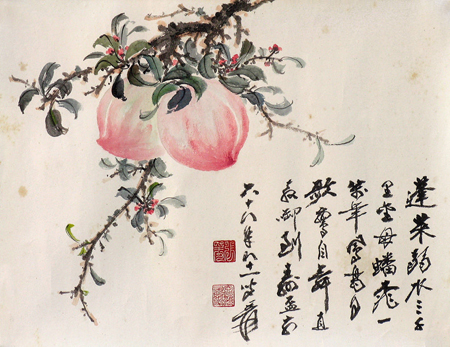
Zhang Daqian (1899-1983) was skilled in many arts, including calligraphy, seal cutting and poetry, but it is for his paintings that he is best known. Yet he is not known for just his own paintings. Zhang Daqian was also a master forger of such quality and prolificness that curators are warned to ask themselves of Chinese paintings with uncertain origins, “Is this a work of Zhang Daqian?” Zhang’s own original paintings are much sought after. He is considered by many to be China’s greatest 20th century painter. Xu Beihong, another celebrated Chinese painter of the age, described Zhang as “one in 500 years,” meaning that Zhang was a rare prodigious artist not just among his contemporaries but of all time.
Almost 80 years after this high praise, Zhang continues to be held as one of the greats. His Cottages in Misty Mountains fetched the highest price at China Guardian’s 2013 Spring Auction – a whopping HK $27.025 million (US $3.5 million). The painting, created in 1965, is bold and dramatic, characteristic of his later works that were influenced by poor eyesight. The painting is dominated by awesome mountains of dark splashed ink surrounded by mists and clouds and interspersed with vibrant green. This composition is full of contrasts. While his unrestrained use of ink creates an overwhelming atmosphere, the painting’s bright splashes of color bring a vivid sense of life.
Zhang’s artistic life was also full of contrasts. Early on, he learnt from the works of ancient masters such as Shi Tao and Bada Shanren of the Qing Dynasty, Xu Wei of the Ming Dynasty and other painters still earlier of the Song and Yuan dynasties. Until the age of 40, he studied and copied ancient paintings, and his forgeries were difficult to detect. Zhang was particularly interested in the Buddhist murals of Dunhuang’s Mogao Grottoes. He spent three years copying these murals, whose origins ranged from the Northern Wei Dynasty to the Sui and Tang dynasties. His forgeries were so convincing that many museums have purchased his versions believing them to be the real McCoy. Today his replications still hang in famous museums around the world, including the British Museum and the Metropolitan Museum of Art.
A Chinese proverb goes, “read ten thousand books and walk ten thousand miles,” expressing the need to experience and go beyond mere book learning to truly understand things. Zhang did just what the proverb said. He left his footprints alongside famous mountains and rivers of the vast Central Plains area, beautiful scenery south of the Yangtze River and the wild north beyond the Great Wall. Not stopping in China, in his 50s he turned his feet abroad. He traveled to Europe and the Americas, and spent time living in Hong Kong, India, Argentina, Brazil and the U.S., visiting cultural and historical attractions all around the world. During his tour he created a large number of poems and paintings, accumulating many materials for use in his art.
Zhang spent his twilight years in Brazil, where his deteriorating eyesight led him to adopt a new style, using splashed ink and bold blues and greens to form a distinctive visual effect. This new style brought him new fame in the painting world. It was during this time that he produced Cottages in Misty Mountains. Zhang also created other splashed ink works such as Rains in Mountains (Shanyuan Zhouyu) and Mountains in Autumn (Qiushan Tu). These works were created using a combination of Zhang’s take on the splashed ink techniques of Wang Qia of the Tang Dynasty and Liang Kai and Mi Fu of the Song Dynasty and the Western chiaroscuro technique – the use of strong contrasts between light and dark – in a whole new approach.
At the China Guardian’s 2010 spring auction, Zhang’s Aachensee Lake (Aihen Hu), a large splashed color on silk, was auctioned off for RMB 100.8 million. This marked the first time that a painting in modern China was sold for over RMB 100 million. It depicts the scenery of Aachen Lake in Switzerland seen from afar. The foreground shows green and undulating mountains that give way to a hidden lake, on the far bank of which are barely discernable houses. The piece, with its abstract mountains that resemble furious waves rolling on the ocean, is a powerful combination of Western abstract art and traditional Chinese art.
Aachensee Lake is considered to be Zhang’s best splashed ink and color painting, and was shown in famous galleries in New York, Boston and Chicago in the 1960s. In 2003, the painting was included in a Chinese modern art exhibition at the Metropolitan Museum of Art in New York.
Throughout his lifetime Zhang created a huge body of work with a wide range of subjects including portraits, landscapes, flowers and birds. You can see much of this in the Mei Yun Tang Collection of Paintings, the most complete collection of his works and greatest pieces. In the late 1950s the institute’s owner and good friend of Zhang, Gao Lingmei, compiled Zhang Daqian’s Paintings, the first book to explore Zhang’s artistic approach. It presents various phases of Zhang’s career and, uniquely, features samples specially produced by Zhang that illustrate each step of his painting process.
